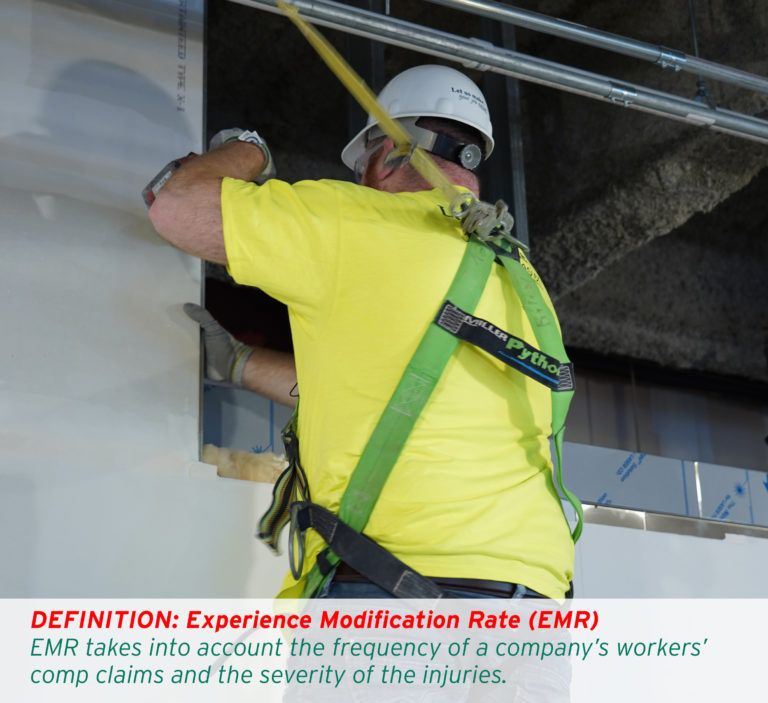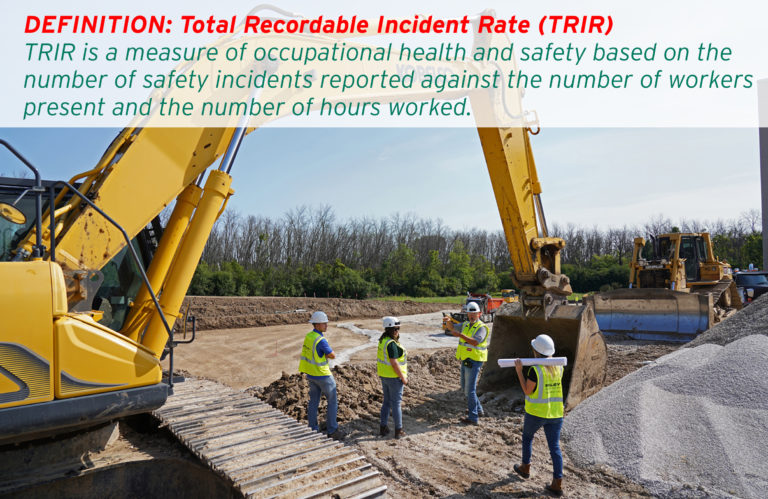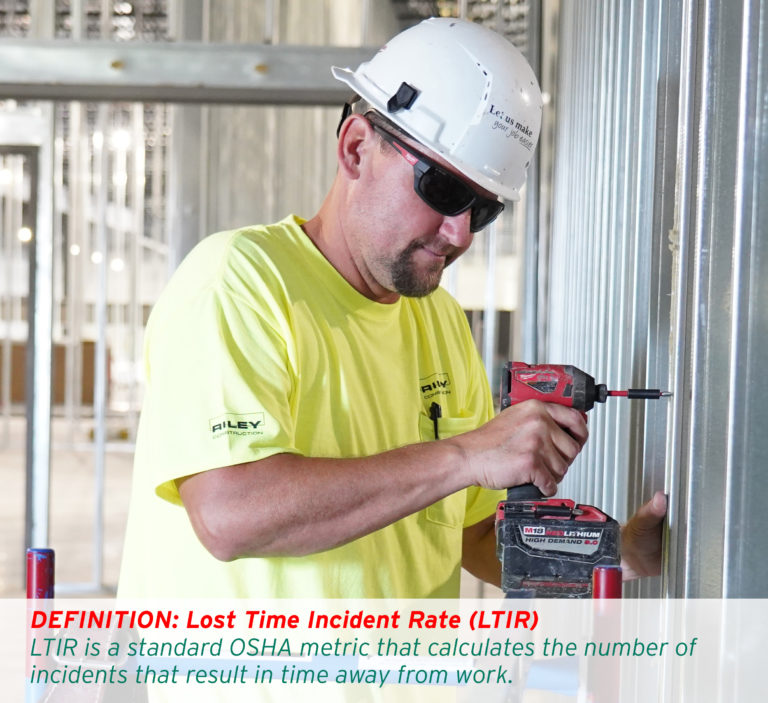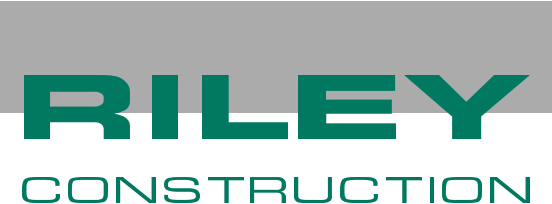The construction industry poses unique safety challenges for workers and those managing projects of any size. The Occupational Safety and Health Administration (OSHA) categorizes falls, caught in-between, struck-by, and electrocution as the “focus four” construction hazards responsible for the majority of jobsite incidents. Riley Construction makes it a priority to build a safety culture with appropriate processes that mitigate the risk of these types of injuries, which can result in project delays and potential lawsuits.
Here’s how Riley approaches safety and risk management to ensure employee safety, help control costs, and reduce overall risks.
CREATING A SAFETY CULTURE REQUIRES COMMITMENT
A culture built on safety is what we’re all about. But what makes Riley a leader when it comes to safety? For one, we actively listen to stakeholders to learn new ways to improve our safety protocol. We also perform diligent steps and work directly with project owners to ensure safety practices are thoroughly outlined and followed. We’ve maintained long-term relationships with many of our subcontractors — many which exceed 20 years. This longevity creates a firm level of trust with our project owners and stakeholders.
Our safety record is stellar, with numbers lower than the national averages and our competitors. We’re proud to be part of a highly regarded, exclusive captive insurance program, in which a number of construction risks – including defects, rework, workers’ comp, and general liability – are covered. We’ve been able to accomplish this through our long-standing record of controlling safety and managing risk.
For example, Experience Modification Rate (EMR) is based on a company’s historical cost of injuries and chances of future risk. Insurance companies use EMRs to  help determine workers’ compensation premium costs, and companies with a lower risk generally have lower premiums. Riley’s current EMR is .56, compared to the national average of 1.0. Our average EMR over the past 22 years has been .62.
help determine workers’ compensation premium costs, and companies with a lower risk generally have lower premiums. Riley’s current EMR is .56, compared to the national average of 1.0. Our average EMR over the past 22 years has been .62.
Other outstanding safety statistics include:
- Total recordable incident rate (TRIR): 1.92 five-year average
- Lost time incident rate (LTIR): .28% five-year average
- Zero OSHA citations in the past 14 years
- Safety and Risk Excellence Top Honors in our captive insurance group for the past five years
These numbers and accolades clearly demonstrate how Riley Construction deeply cares about our workers, subcontractors, and owners by controlling the safety, potential risk, and legality issues for all involved.
EXTENSIVE PLANNING LOWERS RISK DURING PRECONSTRUCTION
During the preconstruction phase, Riley collaborates closely with project owners and subcontractors to ensure we’ve properly identified any potential risks early , before they become a major problem.
, before they become a major problem.
Riley uses a thorough, trustworthy pre-qualification process to manage risk from our subcontractors, in which we review their safety records, EMR, OSHA logs, and other important metrics to pinpoint areas that might need attention during the project. This helps project managers more accurately determine subcontractors with the least potential risk.
Before any project begins, we host kickoff meetings with project executives, project managers, and field leaders, in addition to the quality/lean, safety, technology, and accounting teams. In these meetings, we determine the important client contacts and identify all technology, quality/lean, and insurance compliance needs.
We understand that every construction project poses unique challenges, which is why we create reliable, project-specific safety plans that follow our trusted InSTEP process. Additionally, our project teams ensure that all subcontractors are fully insured and contracted before their work begins.
START EARLY AND FOLLOW UP OFTEN WITH SAFETY PROTOCOLS
At Riley, we follow a “safety first” approach from the get-go. Throughout the construction process, we host daily huddles and weekly jobsite meetings to ensure things are running smoothly and highlight any upcoming safety issues or high-risk work activities that are at least 6 weeks out – giving our team enough time to plan ahead. Constant communication ensures that our operations run efficiently and that all needs are met.
things are running smoothly and highlight any upcoming safety issues or high-risk work activities that are at least 6 weeks out – giving our team enough time to plan ahead. Constant communication ensures that our operations run efficiently and that all needs are met.
During pre-installation meetings, our team addresses potential safety issues related to the upcoming work, in addition to all high-risk work activities — including trenching and excavation, steel erection, crane activities, hot work, and helicopter picks — to make sure all necessary materials (e.g., respirators, fall protection equipment, etc.) are on hand.
Other important safety activities include:
- Jobsite safety walks
- Overview of safety items/OSHA compliances
- Subcontractor huddles
- Safety inspection reports
- Quarterly safety bulletins
l
TRAINING AND A CONTINUOUS IMPROVEMENT MINDSET ARE KEY
The construction industry is one of the world’s top employers, and it’s also one of the riskiest. According to the U.S. Bureau of Labor Statistics, around 150,000 construction-related accidents occur across the country each year. With all the heavy machinery and hazardous materials used on jobsites, safety must be a chief priority for the construction industry. Safety has always been a core value of everything we do. We stand by the notion that our primary job – along with producing high-quality results for our customers – is to get everyone home safely every single night.
To achieve our goals, Riley conducts routine trainings to ensure standard protocols are continuously followed. We also take advantage of opportunities to further apply best practices. We do this by tracking industry trends and thoroughly reviewing any losses to refine our safety practices.
We strongly believe that a resilient safety mindset is the responsibility of all employees, not just the safety team. In other words, safety is everyone’s job. To learn more about how Riley Construction prioritizes safety, contact Senior Field Safety Specialist Jim Janquart (jimj@rileycon.com) or Safety and Risk Manager Mark Toepfer (markt@rileycon.com).

